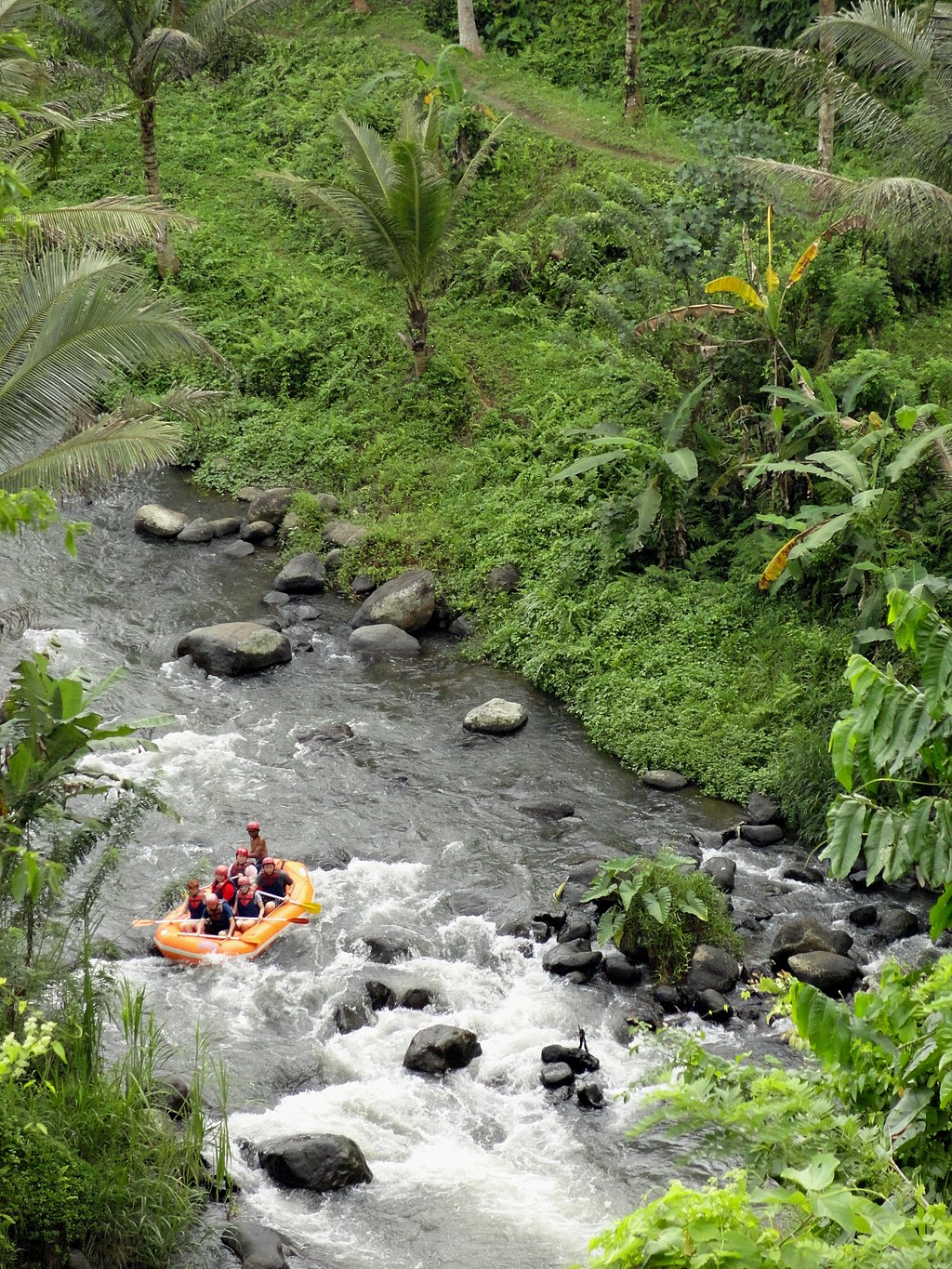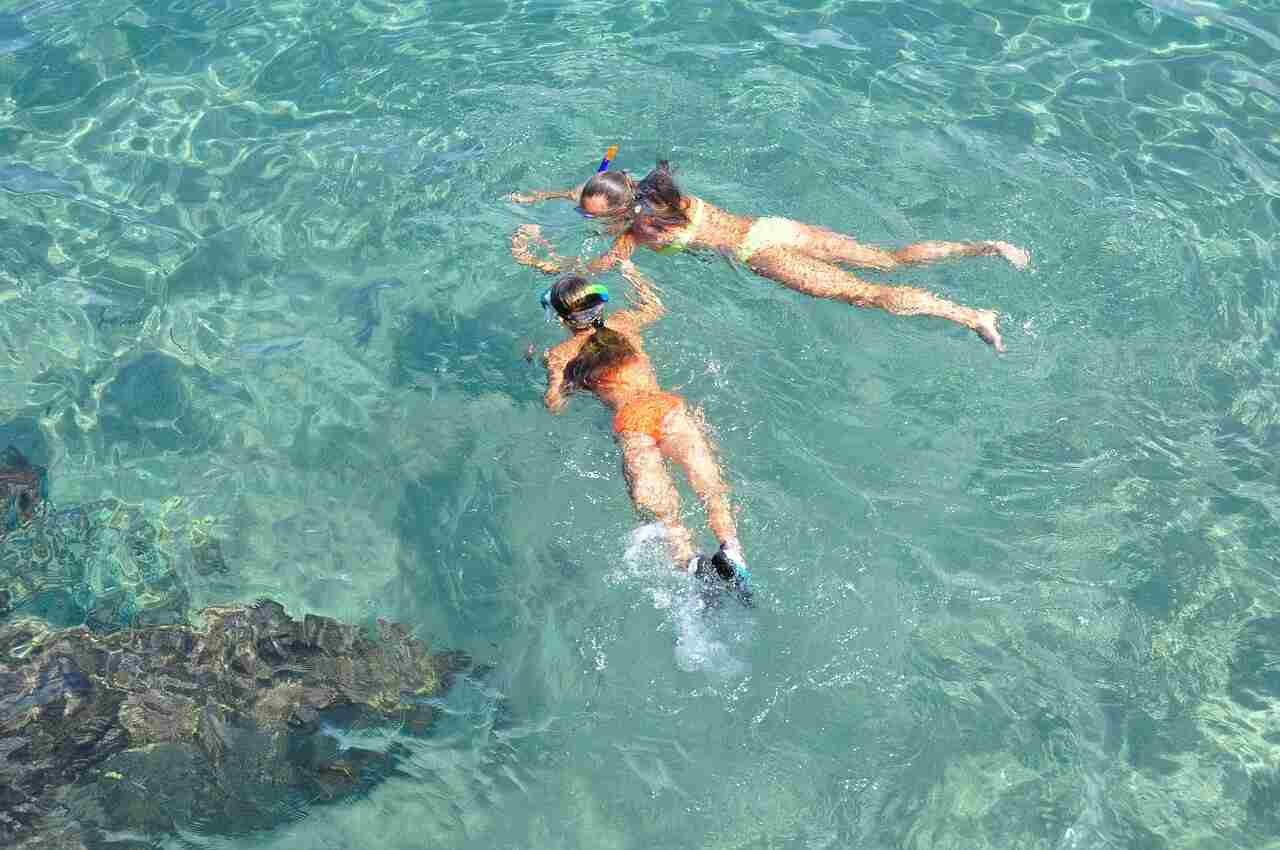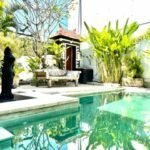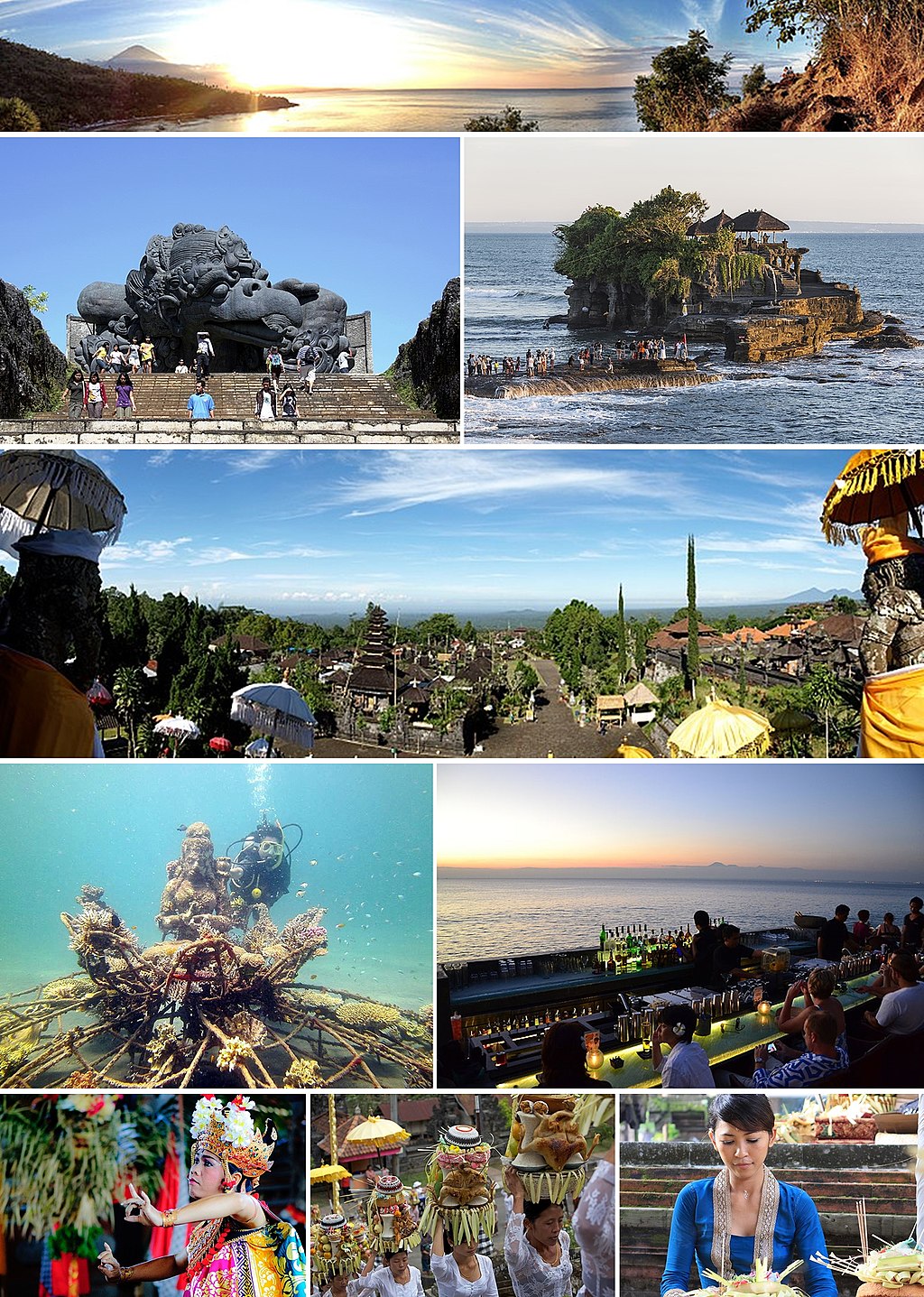Museums in Bali, Inspirational Art and Culture
Bali has a rich cultural and artistic heritage, and its museums offer visitors a unique opportunity to learn about the island’s history, traditions, and contemporary art scene. From traditional Balinese art forms to modern and contemporary art, the museums in Bali showcase a diverse range of exhibits that appeal to a broad audience.
Many of the museums in Bali are located in beautiful settings, with stunning views of Bali’s lush landscape and traditional architecture. The museums also offer a range of events and workshops, such as artist talks, musical performances, and traditional Balinese dance and music classes.
While some of the museums in Bali may have limited space or outdated exhibits, the overall quality of the museums is quite good, and they are generally well-maintained and organized. The museums also provide visitors with an opportunity to support the local arts and culture scene by purchasing artwork or participating in cultural events.
Overall, if you are interested in art, culture, and history, the museums in Bali are definitely worth a visit. They offer a unique and engaging perspective on Bali’s rich heritage and contemporary art scene.
There are several interesting museums in Bali. Here are some examples:
The Agung Rai Museum (ARMA) – Ubud
This museum has a large collection of traditional and contemporary Balinese art, including paintings, sculptures, textiles and ritual objects.
The museum was founded by Agung Rai, a Balinese art collector and philanthropist, in order to preserve and promote traditional Balinese art and culture.
The museum is home to a large collection of Balinese and Indonesian art, including traditional paintings, sculptures, and textiles, as well as contemporary works by local and international artists. The museum is housed in several buildings, each showcasing a different aspect of Balinese culture and art.

Pintu masuk Museum Seni Agung Rai (ARMA) Ubud, Bali, Indonesia. Harditaher, CC BY-SA 4.0, via Wikimedia Commons
One of the highlights of the museum is the Wayang Museum, which features an extensive collection of wayang kulit, or shadow puppets. The museum also includes a traditional Balinese house, or joglo, which has been restored and furnished with antique Balinese furniture.
The Agung Rai Museum also hosts a range of cultural events and activities, such as Balinese dance performances, gamelan music concerts, and traditional puppet shows. The museum also offers a range of educational programs, including art classes, workshops, and lectures, allowing visitors to learn more about Balinese art and culture.

The front room of the Agung Rai Museum of Art. Harditaher, CC BY-SA 4.0, via Wikimedia Commons
What is wayang?
Wayang is a traditional form of puppet theatre that originated in Indonesia and is most commonly associated with the island of Java. The term “wayang” refers to both the puppets themselves and the performance art of puppetry.
Wayang puppets are typically made of wood, although some may be made of leather or other materials. The puppets are intricately carved and painted, with movable arms, legs, and heads. Each puppet represents a different character, with distinct personalities and characteristics.
Wayang performances typically tell stories from ancient Javanese epics, such as the Ramayana and Mahabharata. The puppeteer, known as a dalang, sits behind a screen and manipulates the puppets while simultaneously narrating the story and providing voices for the different characters. The dalang is often accompanied by a gamelan orchestra, which provides musical accompaniment to the performance.
Wayang is a highly respected and revered art form in Indonesia, and is considered an important part of the country’s cultural heritage. In addition to its artistic and cultural significance, wayang has also played a role in education and moral instruction, as many stories feature moral lessons and teachings.
Today, wayang continues to be performed throughout Indonesia and has also gained international recognition as a unique and fascinating form of puppet theatre.
The museum is open daily from 9 am to 6 pm, with guided tours available for groups. Admission fees apply, with discounts available for students and children.
Overall, the Agung Rai Museum (ARMA) is a fantastic destination for anyone interested in Balinese art and culture. The museum provides a comprehensive and engaging perspective on Balinese art and culture, with a range of exhibits, events, and educational programs to suit all interests.
Address: Jl. Raya Pengosekan Ubud, Bali, 80571, Indonesia.
Open daily from 9:00 a.m. to 6:00 p.m.
http://villacarissabali.com/balinese-paintings-exploring-balis-artistic-schools-types-heritage/
The Puri Lukisan Museum, the Painting Museum of Ubud
This museum is one of Bali’s oldest art museums and features a large collection of modern and traditional Balinese artwork. This Balinese art museum has a collection of traditional and modern paintings, sculptures and artwork.

The Burning of Lontar by I Gusti Ketut Kobot, 1958, Museum Puri Paintings. Pinerineks, CC BY-SA 4.0, via Wikimedia Commons
The museum was founded in 1954 by Tjokorda Gede Agung Sukawati, the prince of Ubud, with the aim of preserving and promoting traditional Balinese art and culture.
The museum’s collection consists of traditional Balinese paintings, sculptures, and textiles, as well as contemporary works by local and international artists. The collection is divided into several galleries, each showcasing a different aspect of Balinese art and culture.
One of the highlights of the museum is its collection of works by the Ubud School of Painting, a group of Balinese artists who gained international recognition in the 1930s and 1940s. The museum also features works by other notable Balinese artists, including I Gusti Nyoman Lempad, Ida Bagus Made, and Anak Agung Gede Sobrat.
The Puri Lukisan Museum is housed in a series of traditional Balinese-style buildings, with high-pitched thatched roofs and intricately carved wooden doors and windows. The museum is surrounded by lush gardens and offers stunning views of the surrounding rice paddies and tropical forest.
In addition to its permanent collection, the Puri Lukisan Museum also hosts temporary exhibitions, workshops, and cultural events. The museum offers guided tours and educational programs, allowing visitors to learn more about Balinese art and culture.

Ogoh-ogoh statues (demonic figures) in front of the Puri Lukisan Museum in Ubud. MagdaLena7, CC BY-SA 4.0, via Wikimedia Commons
History
This Museum of Fine Arts was erected in 1956 thanks to the alliance of two important figures: Cokorda Raka Sukawati, Prince of Ubud from 1910 to 1978 and the Dutch painter Rudolf Bonnet. This is the oldest art museum in Bali which specializes in Balinese paintings and sculptures. At the origin of this museum, the fear of seeing Balinese art disappear throughout the world, without keeping any trace of it within it: Ubud Bali. Indeed, Balinese art becoming world famous, paintings and sculptures began to leave for foreign countries or other Indonesian regions.
The famous Dutch painter thought that at this rate, works of art would disappear forever, scattered around the world. For this reason, in 1936, together with the prince, they created a foundation called Pita Maha. Little by little, a second foundation was born in 1953, then the first stone of the museum was laid in 1954. Prince Cokorda Raka Sukawati became the director of the museum and Rudolf Bonnet, its curator.
To supply the museum, Rudolf Bonnet began by depositing the works of art in his possession there. Subsequently, other artists donated their paintings to give this museum all the grandeur it deserved. In total, three pavilions make up this exceptional Museum of Painting.
Address: Jl. Raya Ubud, Ubud, Gianyar, Bali 80571, Indonesia.
The museum is located on the main street of Ubud, 300m (984ft or 0.18 mile) from Ubud Palace and Ubud Market at the intersection of Monkey Forest Road.
Open daily from 9:00 a.m. to 5:00 p.m., with admission fees applying. Discounts are available for students and groups. Overall, the museum is a must-visit destination for anyone interested in Balinese art and culture, providing a comprehensive and engaging perspective on the island’s rich artistic heritage.
The Neka Museum – Ubud
This museum houses a large collection of traditional and contemporary Balinese art, as well as works by foreign artists who have worked in Bali.
It was founded by Suteja Neka, a Balinese art collector, in 1982 with the aim of preserving and promoting traditional Balinese art.
The museum’s collection includes a wide range of Balinese art, including traditional paintings, sculptures, and textiles, as well as contemporary works by local and international artists. The museum’s collection is divided into several galleries, each focusing on a different aspect of Balinese art and culture.
One of the highlights of the museum is its collection of works by renowned Balinese artist I Gusti Nyoman Lempad. The museum also features a large collection of works by other notable Balinese artists, including Ida Bagus Made, Ida Bagus Tilem, and Ida Bagus Nyoman Rai.
The Neka Museum is housed in a traditional Balinese-style building, with a series of high-pitched roofs and intricate carvings on the walls and doors. The museum is surrounded by lush gardens and offers stunning views of the surrounding rice paddies.

The Death of Abhimanyu (Abhimanyu Gugur), a painting at the Neka Art Museum in Ubud, Bali. Late 19th century; mineral pigments, indigo, and ink on bark cloth; 100 x 106 cm. Anonymous. Kamasan, Klungkung, Bali. Mx. Granger, Public domain, via Wikimedia Commons
In addition to its permanent collection, the Neka Museum also hosts a range of temporary exhibitions, workshops, and cultural events. The museum offers guided tours and educational programs, allowing visitors to learn more about Balinese art and culture.
The Neka Museum is open daily from 9 am to 5 pm, with admission fees applying. Discounts are available for students and groups. Overall, the Neka Museum is a must-visit destination for anyone interested in Balinese art and culture, providing a comprehensive and engaging perspective on the island’s rich artistic heritage.
NEKA Art Museum, Ubud. User: (WT-shared) Shoestring at wts wikivoyage, CC BY-SA 1.0, via Wikimedia Commons
Address: Jl. Raya Sanggingan, Kedewatan, Ubud, Gianyar, Bali 80571, Indonesia.
Open daily from 9:00 a.m. to 5:00 p.m.
Blanco Renaissance Museum – Ubud
This museum is dedicated to the life and work of the painter Antonio Blanco, who lived in Bali for several decades. It houses Blanco’s paintings, drawings, sculptures and personal items.
It was founded by the Philippine-born artist Antonio Blanco, who lived and worked in Bali for over 40 years until his death in 1999. The museum showcases a collection of his works, as well as the works of his son, Mario Blanco.

Workshop of Antonio Blanco. SylvieM, CC BY-SA 4.0, via Wikimedia Commons
The museum is housed in a stunning building, with Balinese architecture and lush gardens. It is divided into several galleries, each displaying a different period of Blanco’s art. The galleries are adorned with his paintings, drawings, and sculptures, showcasing his distinctive style, which blends Western and Balinese artistic traditions.
Antonio Blanco’s workshop in his museum. Taguelmoust, CC BY-SA 3.0, via Wikimedia Commons
The Blanco Renaissance Museum also features a studio and workshop, where visitors can watch artists at work and even try their hand at painting or drawing. The museum offers a range of art classes and workshops, allowing visitors to explore their own creativity and learn more about Balinese art and culture.
In addition to the permanent collection, the museum also hosts regular temporary exhibitions, featuring the works of other artists, both local and international.
Antonio Blanco Museum, Ubud, Bali, Indonesia. Taguelmoust, CC BY-SA 3.0, via Wikimedia Commons
The museum is open daily from 9 am to 5 pm, with guided tours available for groups. Admission fees apply, with discounts available for students and children.
Overall, the Blanco Renaissance Museum is a must-visit destination for art lovers and those interested in Balinese art and culture. The museum provides a unique and engaging perspective on the life and works of Antonio Blanco and his legacy in Bali’s art scene.
Address: Jl. Raya Penestanan, Sayan, Ubud, Gianyar, Bali 80571, Indonesia.
Open daily from 9:00 a.m. to 5:00 p.m. The museum houses a collection of paintings, sculptures and works of art by the Spanish painter Antonio Blanco.
Rudana Museum – Ubud
The Rudana Museum & Rudana Fine Art Gallery is a museum of contemporary Indonesian art located in the village of Peliatan in Ubud, Bali. The museum was founded in 1995 by Nyoman Rudana, a Balinese art collector and entrepreneur, and features a collection of modern and contemporary Indonesian art.
The museum’s collection includes works by some of Indonesia’s most well-known artists, such as Affandi, S. Sudjojono, and Raden Saleh. The exhibits include paintings, sculptures, and mixed-media installations, as well as traditional Balinese art forms such as Wayang Kulit (shadow puppetry) and Batuan-style paintings. The museum has a strong focus on showcasing the diversity and richness of Indonesian art and culture.
The museum’s building is a beautiful example of traditional Balinese architecture, with open-air pavilions and courtyards featuring intricate carvings and sculptures. The museum’s location on a hillside also provides visitors with stunning views of the surrounding rice paddies and tropical landscape.
In addition to its exhibits, the Rudana Museum also hosts regular events and workshops, such as artist talks, musical performances, and art classes. Visitors can also enjoy a meal or refreshment at the museum’s on-site restaurant and cafe.
The Rudana Museum is open every day from 9 am to 5 pm, and admission fees apply. Discounts are available for children and groups. Overall, the museum is a must-visit destination for anyone interested in contemporary Indonesian painting art and culture.
Address: Jl. Cok Rai Pudak No. 44, Peliatan, Ubud, Bali, Indonesia. It is situated about 2 km east of the central Ubud area and can be easily accessed by car or motorbike.
Open every day from 10 am to 4 pm.
There are several museums in Bali outside of Ubud, here are some examples
Le Mayeur Museum in Sanur
This museum is dedicated to the Belgian artist Adrien-Jean Le Mayeur de Merprès, who lived in Bali for more than 25 years and produced many works inspired by the island. The museum is housed in the former residence of Le Mayeur, who lived in Bali from 1932 until his death in 1958.
The museum displays a collection of Le Mayeur’s paintings, which are known for their vibrant colors and depiction of Balinese daily life. Many of the paintings feature Balinese women, whom Le Mayeur considered his muse, and showcase their traditional costumes, dances, and ceremonies. The museum also features some of Le Mayeur’s personal belongings, including furniture, photographs, and art materials.

Reclining nude by Czesław Mystkowski. Czeslaw Mystkowski (1898-1938), Public domain, via Wikimedia Commons
The building
The building itself is a beautiful example of traditional Balinese architecture, with an open-air layout and intricate carvings on the walls and ceilings. The museum is surrounded by a lush tropical garden, which provides a peaceful and serene atmosphere for visitors.

Museum Pasifika. Museum Pasifika, CC BY-SA 4.0, via Wikimedia Commons
In addition to its collection, the Le Mayeur Museum also hosts temporary exhibitions and cultural events, such as traditional dance performances and music concerts. The museum’s location in Sanur, a popular beach resort town, also makes it a great destination for tourists looking to experience both Balinese culture and natural beauty.
The museum is open every day from 8 am to 4 pm, except on Sundays and public holidays. Admission fees apply, with discounts available for students and groups. Overall, the Le Mayeur Museum is a must-visit for art enthusiasts and anyone interested in learning about Balinese culture and history.
Address: Jl. Hang Tuah, Sanur, Denpasar Sel., Kota Denpasar, Bali 80227, Indonesia.
Open daily from 8:00 a.m. to 4:00 p.m. Except on Sundays and public holidays
Pasifika Museum in Nusa Dua
This contemporary art museum houses an impressive collection of Asian and Oceanian artwork, with a strong presence of Balinese art.
The museum is dedicated to the art and culture of the Pacific region, featuring a collection of traditional and contemporary art from various countries in the Pacific.
The museum’s collection includes artworks from Indonesia, the Philippines, Papua New Guinea, Fiji, Vanuatu, and other Pacific islands. Visitors can explore the exhibits which showcase a diverse range of art styles, including paintings, sculptures, textiles, and mixed media works. The museum also features interactive displays and multimedia installations, providing a unique and engaging experience for visitors.
One of the highlights of the Pasifika Museum is its collection of works by Balinese artist Nyoman Gunarsa. Gunarsa is known for his colorful and expressive paintings that depict traditional Balinese scenes and mythology. The museum also has a collection of works by other prominent Indonesian artists, including Affandi and Raden Saleh.
The Pasifika Museum is housed in a beautiful building that features traditional Balinese architecture with a modern touch. The museum is surrounded by lush tropical gardens, providing a tranquil and peaceful atmosphere for visitors.

Museum Pasifika, Nusa Dua, Bali, Indonesia. Lasthib, CC BY-SA 4.0, via Wikimedia Commons
In addition to its collection, the museum also offers cultural workshops, art classes, and guided tours. The museum’s location in Nusa Dua, a popular tourist destination, makes it an ideal destination for those looking to experience both Balinese culture and art from the wider Pacific region.
The museum is open every day from 10 am to 6 pm, and admission fees apply. Discounts are available for children, students, and groups. Overall, the Pasifika Museum is a fascinating attraction for art enthusiasts and anyone interested in the rich culture and history of the Pacific region.
Address: Complex Bali Tourism Development Corporation (BTDC), Nusa Dua, Benoa, South Kuta, Badung Regency, Bali 80363
Open daily from 10 a.m. to 6 p.m.
Bali Museum, Denpasar Historical Museum
This museum showcases the history of Bali from prehistoric times to the present day, with exhibits on the island’s art, culture and traditions.
The Denpasar Historical Museum, also known as the Bali Museum, is a museum located in the capital city of Denpasar, Bali, Indonesia. The museum was founded in 1932 and is dedicated to preserving and showcasing the cultural and historical heritage of Bali.
The museum’s collection includes a wide range of objects, such as traditional clothing, ceremonial objects, musical instruments, and paintings. The exhibits are accompanied by detailed explanations of the cultural and historical significance of each object.
In addition to its exhibits, the museum also hosts regular cultural events, such as Balinese dance performances and traditional music concerts. The museum’s location in the heart of Denpasar also makes it a convenient stop for those exploring the city.
The human penis in the Bali museum in Denpasar in Bali. Rudolph.A.furtado, CC0, via Wikimedia Commons
The museum’s exhibits are spread across four buildings, each representing a different period of Balinese history. The first building focuses on prehistoric Bali, featuring artifacts such as stone tools and pottery. The second building covers the Hindu-Javanese period, with displays of statues, carvings, and textiles from the 8th to 16th century. The third building covers the Dutch colonial period, with exhibits on colonial life and the Balinese resistance. Finally, the fourth building covers the post-colonial era and Bali’s modern history.

Bali Museum in Denpasar. Christophe95, CC BY-SA 4.0, via Wikimedia Commons
The museum was built in 1931 by architect P.J. Moojen, near the location of the former royal palace of Denpasar, which had been burnt to the ground during the Dutch intervention in Bali (1906), and used it as a model for its outside walls and courtyards.

Bali Museum in Denpasar. Christophe95, CC BY-SA 4.0, via Wikimedia Commons
The building is constructed from carved teak wood, with a series of high-pitched roofs and intricate carvings on the walls and doors. The museum is divided into several pavilions, each showcasing different aspects of Balinese art and culture.
Main pavilion
The main pavilion of the Bali Museum is known as the “Tabanan Pavilion,” and it features a collection of prehistoric and historical artifacts from the island of Bali, including pottery, tools, and weapons. The pavilion also includes a replica of a traditional Balinese village, showcasing the daily life and customs of the Balinese people.
Another pavilion of the museum, the “Gianyar Pavilion,” is dedicated to Balinese art, including traditional paintings, sculptures, and textiles. The pavilion showcases the evolution of Balinese art from ancient times to the present day.
The Bali Museum also includes a special pavilion dedicated to Balinese masks and puppets, known as the “Klungkung Pavilion.” The pavilion features an extensive collection of masks and puppets, which are an important part of Balinese theater and performance.

Bali Museum, inside courtyards and gates, seen from the belvedere. PHGCOM, CC BY-SA 3.0, via Wikimedia Commons
The Denpasar Historical Museum is open every day except on major holidays, from 8 am to 3 pm. Admission fees apply, with discounts available for children and groups. Overall, the museum is a must-visit destination for anyone interested in Balinese culture and history.
Address: Denpasar Historical Museum: Jl. Mayor Wisnu No.1, Bali, 80232, Indonesia.
Open Tuesday to Thursday from 8:00 a.m. to 3:00 p.m. and Friday from 8:00 a.m. to 1:00 p.m.
Mask and Puppet Museum (Setia Darma House) in Gianyar (20 minutes from Ubud)
The Mask and Puppet Museum, also known as Setia Darma House, is a museum located in the Gianyar regency of Bali, Indonesia. The museum is home to a large collection of masks and puppets from Indonesia and other parts of the world.
The museum was established in 2006 by Mr. Hadi Sunyoto, a collector of traditional Indonesian masks and puppets. The museum is set in a beautiful garden, and visitors can stroll through the grounds and admire the traditional Balinese architecture. The collection includes over 1,300 masks and over 4,500 puppets from Indonesia and other parts of the world.
The museum is divided into different sections, each dedicated to a specific type of mask or puppet. For example, there is a section for wayang kulit (shadow puppets), a section for topeng (masks used in dance dramas), and a section for masks used in traditional Balinese ceremonies. Visitors can also see traditional puppets and masks from other parts of Indonesia and other countries, such as India and China.
In addition to the museum’s collection, Setia Darma House also hosts workshops and performances, where visitors can learn about traditional puppet and mask making techniques or watch performances by local artists. The museum also has a café and a gift shop where visitors can purchase traditional Balinese crafts and souvenirs.
Collections
The museum’s collection includes over 1,300 masks and over 4,500 puppets, representing various types and styles of Indonesian and Balinese masks and puppets. Some of the types of masks and puppets on display at the museum include:
- Wayang kulit (shadow puppets)
- Wayang golek (rod puppets)
- Topeng (masks used in dance dramas)
- Barong and Rangda masks (used in traditional Balinese ceremonies)
- Janger masks (used in the Janger dance)
- Chinese and Indian masks and puppets
The museum is located in a beautiful garden setting, featuring traditional Balinese architecture. Visitors can wander through the museum’s grounds, admiring the exhibits and taking in the peaceful atmosphere. The museum is also known for hosting performances and workshops, where visitors can learn about traditional mask and puppet making techniques or watch performances by local artists.
In addition to the museum’s collection, Setia Darma House also has a café and a gift shop where visitors can purchase traditional Balinese crafts and souvenirs.
Overall, the Mask and Puppet Museum in Gianyar is a must-visit destination for anyone interested in traditional Indonesian culture and art, and is a great way to learn about the rich history and traditions of Balinese puppetry and mask making.
Address: Jl. Setia Budi No. 8, Gianyar, Bali 80511, Indonesia.
Open daily from 8:00 a.m. to 4:00 p.m.
Subak Museum in Tabanan
Subak is a traditional Balinese irrigation system that has been in use for over a thousand years, providing a reliable and sustainable water supply to rice paddies and other crops.
Subak museum is dedicated to the traditional Balinese irrigation system known as subak. The museum is located in a traditional Balinese house with a beautiful garden.
The subak irrigation system is an ancient system that was developed by the Balinese farmers to ensure a sustainable and efficient use of water for irrigation. The system consists of a series of canals, weirs, and tunnels that distribute water from the rivers to the rice fields. This system has been in use for over a thousand years and is still in use today.

Jatiluwih Rice Terraces with Subak irrigation system. Imacim, CC BY-SA 4.0, via Wikimedia Commons
This ingenious system is based on the principles of collaboration, conservation, and culture, and is managed by local farmers through a complex network of canals, tunnels, and water temples. Subak not only supports Bali’s agriculture but also represents an essential part of the island’s cultural heritage and identity.
SUBAK MUSEUM (Tabanan): Ce qu’il faut savoir pour votre visite 2023
Avis Questions et réponses Contrôle des avis Avant publication, chaque avis passe par notre système de suivi automatisé afin de contrôler s’il correspond à nos critères de publication. Si le système détecte un problème avec un avis, celui-ci est manuellement examiné par notre équipe de spécialistes de contenu, qui contrôle également tous les avis qui nous sont signalés après publication par notre communauté.
Displays
The Subak Museum displays a collection of traditional tools and equipment used in the subak irrigation system, including bamboo pipes, wooden water wheels, and traditional farming tools. The museum also has a collection of paintings, photographs, and models that illustrate the history and development of the subak irrigation system.
In addition to its collection, the museum also provides information on the culture and traditions of the Balinese people. Visitors can learn about the role of the subak system in Balinese society and the importance of water management for the sustainability of the island’s agriculture.
Overall, the Subak Museum is an interesting and informative attraction for those interested in learning about Balinese culture, history, and agriculture. It is open every day from 9 am to 5 pm, and admission is free.
Address: Jl. Kediri, Belalang, Kediri, Tabanan Regency, Bali 82121, Indonesia.
Open daily from 8:00 a.m. to 4:00 p.m.
Their website (in Indonesian language): http://museumsubak.com
These are just a few examples of museums in Bali outside of Ubud. There are also other museums to discover according to your interests.
Please note that opening hours may vary due to local holidays and events, so it’s best to check times before visiting the museum. Additionally, it is important to respect local rules and customs when visiting these museums, especially regarding appropriate dress and respectful behavior.
Gedong Kirtya Museum and Library in Singaraja (North Bali)
Gedong Kirtya is a museum and library located in Singaraja, Bali, Indonesia. It is known for its vast collection of Balinese and Indonesian manuscripts and lontar (palm-leaf manuscripts) that document Balinese culture, history, and religion.
The museum was founded in 1928 by Gusti Putu Jelantik, a member of the royal family of Buleleng, and it was officially opened to the public in 1953. The museum was established as a repository for ancient Balinese manuscripts, with the aim of preserving and promoting Balinese culture and heritage.
museum gedong kirtya – Photo de Gedong Kertya Museum, Singaraja – Tripadvisor
Gedong Kertya Museum, Singaraja Photo : museum gedong kirtya – Découvrez les 15 photos et vidéos de Gedong Kertya Museum prises par des membres de Tripadvisor.
The collection at Gedong Kirtya includes over 4,000 manuscripts and lontar, some of which date back to the 10th century. The collection includes religious texts, histories, genealogies, calendars, and literature, all written in the Balinese script. The manuscripts and lontar are made from palm leaves that have been inscribed with a sharp tool and bound together with string.
Visitors to Gedong Kirtya can view the manuscripts and lontar in the museum’s reading room, which is open to the public. The museum also has a research library that is accessible to scholars and researchers.
In addition to its collection of manuscripts and lontar, Gedong Kirtya also has a collection of traditional Balinese paintings and sculptures, as well as a collection of antique weapons and armor.
Address: Jl. Veteran No. 23, Singaraja, Buleleng, Bali, Indonesia
Opening Hours:
Monday – Friday: 8:00 am to 3:00 pm
Saturday: 8:00 am to 2:00 pm
Sunday and Public Holidays: Closed
Buleleng Museum (Singaraja – North Bali)
The Buleleng Museum is a cultural treasure located in the heart of the Buleleng region of Bali. It offers a fascinating insight into the life of the last Raja of Buleleng, Pandji Tisna, an iconic figure who contributed greatly to the development of tourism in Lovina and throughout West Bali.
Among the jewels of this collection is the Royal typewriter, Pandji Tisna’s faithful companion in writing his travel stories until his death in 1978. This object, steeped in history, testifies to his commitment to documenting and share his love for the region.
In addition to this relic, the museum houses a multitude of precious artifacts and objects that tell the rich and diverse history of Buleleng. From traditional artwork to ancient tools, each piece offers a unique insight into the culture and traditions of this community.
The Buleleng Museum also aims to be a place of education and awareness. It offers detailed information on the history of the region, enlightening visitors on the events and people who shaped Buleleng’s destiny.
To discover this cultural treasure, go to the Jl Veteran 23. The museum opens its doors Monday to Friday, from 9 a.m. to 4 p.m. This is the perfect opportunity to delve into the captivating history of Buleleng and its notable personalities. An unforgettable experience for history lovers and curious people eager for cultural discoveries.
Most famous Bali painter
I Gusti Nyoman Lempad (1862-1978) is considered one of the most famous painters from Bali. He was born in 1862 in Bedulu village near Ubud and lived to be over 100 years old. Lempad is known for his distinctive style, which combines traditional Balinese themes with modern influences, including elements of Art Nouveau and Art Deco.
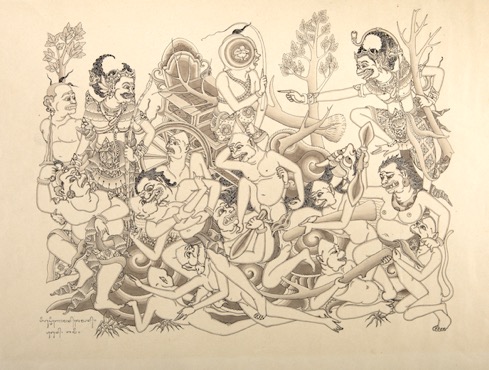
Ramayana by I Gusti Nyoman Lempad. Museum Pasifika, Public domain, via Wikimedia Commons
Lempad was not only a painter but also an architect, sculptor, and calligrapher. He played an important role in the development of Balinese art and culture and was influential in the formation of the Ubud School of Painting, which gained international recognition in the 1930s and 1940s.
Lempad’s work is characterized by its strong lines, bold compositions, and attention to detail. He often depicted scenes from Balinese mythology and daily life, as well as landscapes and architecture. Some of his most famous works include the mural paintings at the Puri Lukisan Museum in Ubud and the bas-relief sculptures at the Tirta Empul temple in Tampaksiring.
Today, Lempad’s legacy continues to inspire generations of Balinese artists and his work is highly sought after by collectors around the world.
Where to see I Gusti Nyoman Lempad arts?
If you would like to see I Gusti Nyoman Lempad’s art, there are several places in Bali where his works can be found.
One of the best places to see his works is at the Puri Lukisan Museum in Ubud, which has a large collection of Lempad’s paintings and drawings. The museum also houses works by other famous Balinese artists, including his contemporaries from the Ubud School of Painting.
Another place to see Lempad’s art is at the Neka Art Museum, also located in Ubud. The museum has a collection of his sketches and drawings, as well as paintings by other Balinese artists.
In addition, some of Lempad’s sculptures can be found at the Tirta Empul temple in Tampaksiring, which is known for its elaborate carvings and bas-reliefs.
Finally, there are also galleries and private collections throughout Bali that feature Lempad’s works. It’s always a good idea to do some research ahead of time or ask for recommendations from locals or art experts to find specific pieces or collections.
Photo credit: workingzen via Pixabay
Notes: It’s worth noting that some of the museums may be closed for renovations or during Balinese religious holidays.
Have you booked your private villa in Seminyak center?
Located in Seminyak Center – Bali, Villa Carissa offers a private swimming pool and enclosed garden to guarantee your privacy. You can book your private pool villa here with us.
Whether you’re traveling with family, friends, or on a romantic getaway, villa Carissa in Seminyak center offers the perfect base for exploring Bali’s many attractions and enjoying a relaxing vacation.





















